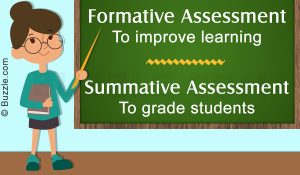The Pro’s and Cons of Formative Assessment
There are a variety of pros and cons of formative assessment. In my opinion, I believe the pros outweigh the cons of formative assessment because if formative assessment is done correctly, there are no disadvantages to the student. Ultimately, this type of assessment is considered time consuming for teachers as they analyze results from daily assessments to provide detailed feedback to each student. In my future teaching, I would like to implement more formative assessment than summative assessment into my classroom, because I believe that the progress in student’s learning will become more evident.
What is Formative Assessment?
Formative assessments are a way that teachers are able to check the understanding of the students throughout a lesson, instead of waiting until the end of a lesson to test their knowledge. Formative assessments support the learning of students and allows for teachers to check for understanding.
Advantages of Formative Assessment
The advantages of formative assessment include; that formative assessments are not graded, teachers are able to check for understanding, therefore if a student is struggling during a lesson they can get the help they need in class. Additionally, the most common form and example of formative assessment is ongoing feedback. If teachers are able to provide ongoing feedback, the students are able to make changes to their learning style or even adapt or change the way they are doing something, without being graded.When formative assessment is implemented, some of the benefits include: defined learning goals, increased rigor, improved academic achievement, enhanced student motivation, increased student engagement, personalized learning experiences, self-regulated learners and data-driven decisions.
Disadvantages of Formative Assessment
Once again, if formative assessment is implemented well there is little to none disadvantages of formative assessment. Some of the downfalls, however, include; not having enough time to assess during a lesson, teachers feel rushed to complete a lesson, teachers may lack training on how to use formative assessment and if a teacher consistently uses formative assessment in their classroom, the students may not take it seriously.
Types of Formative Assessment
Some types of formative assessment include; teachers using summarising techniques, digital or non-digital portfolios, checklists, collaborative work, group projects and small achievable goals (goal setting). Other examples include; using round robin charts, strategic questioning, three-way summaries, think-pair-share, 3-2-1 countdown, classroom polls, exit/ admit tickets and creative extension projects.
When to use formative assessment?
The ultimate goal of formative assessment is to gauge student learning and adapt content correctly. Formative assessment should be used to monitor students learning progress during the lesson, or even when the teacher is teaching the lesson, by focusing on one or two students for different parts of the lesson, it will ensure all students are being assessed. However, this is one of many strategies.
Below is a link to a video, which discusses what formative assessment is and some strategies and examples to go along with it:
http://https://study.com/academy/lesson/what-is-formative-assessment-strategies-examples.html
What is the difference between Formative and Summative Assessment:
